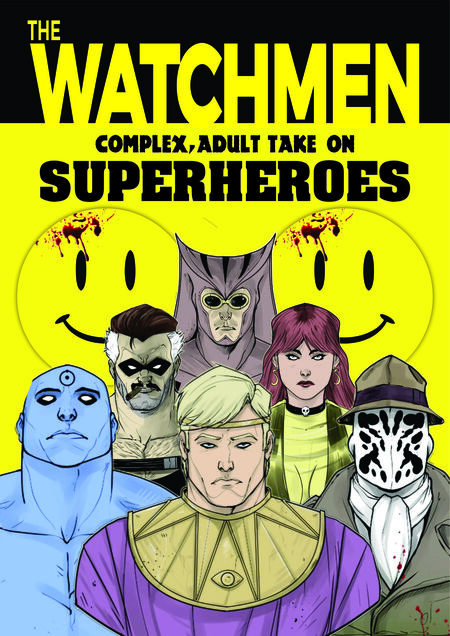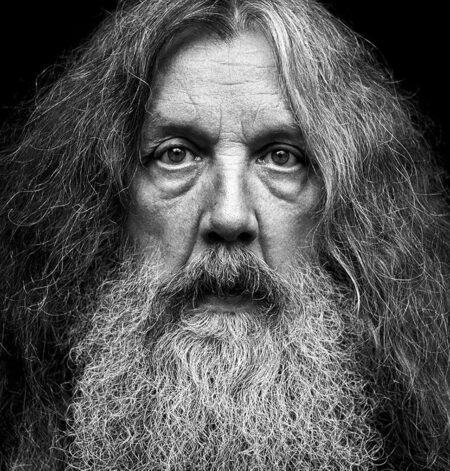
WATCHMEN: COMPLEX, ADULT TAKE ON SUPERHEROES
ALAN MOORE

Alan Moore is acclaimed for his profound influence on comics. A British writer, born in Northampton, England, in 1953, Alan Moore is a creative comic book author whose work transformed the graphic novel genre. He is known for subverting traditional comic tropes and embedding political and social critique in his narratives. Watchmen cemented Moore’s reputation as a literary innovator in the 1980s.
A SYNOPSIS OF WATCHMEN
The dark, non-linear mystery Watchmen takes place in a different Cold War era when superheroes have changed the course of history. It examines these heroes' moral dilemmas in the face of impending nuclear war and focuses on their psychological complexity.
CREATIVE ROUTE AND ESSENTIAL COMPONENTS
Moore was convinced to produce original analogues, which allowed for greater creative flexibility, after the original concept was developed using Charlton Comics characters. The story’s design, which included Dave Gibbons' painstaking character illustrations, came together naturally but deliberately. Watchmen makes use of advanced literary devices including many perspectives and symmetry in narrative. Its narrative depth revolves around the investigation of time perception and free agency. In order to make the work complex and multi-layered, Moore also incorporated ironies and self-references throughout.
Watchmen’s dissection of superhero mythology is its most significant feature. By showcasing incredibly flawed individuals driven by psychological issues rather than pure generosity, it subverts the idealism of conventional comedic heroism. This strategy prompted readers to reconsider presumptions regarding morality and bravery.
MASTERPIECE AND EXPERIMENTATION
Many people consider Watchmen to be a masterpiece that redefined comic storytelling. Alongside comics like Maus and The Dark Knight Returns, it was a part of a late 1980s trend toward more adult, mature sensibilities. The series showed the literary possibilities of the comic book genre and was more than just an experiment. It was a revolutionary work. A darker, more complex period in superhero comics was sparked by its influence.
RECEPTION AND COMMERCIAL SUCCESS
Watchmen received critical praise and lasting cultural significance despite not being a huge monetary success at first. It was recognized for its literary excellence with a Hugo Award, a rare honor for comics. Some criticize it as being overrated, frequently because of its intricate and complicated concepts that could be intimidating to non-readers. Nonetheless, its high standing in comic history is justified by its inventiveness and depth of tale.
CONTEXT AND SIGNIFICANCE
Watchmen, which represent concerns about nuclear war and suspicion of the government, fit with the social and political anxieties of the Cold War era. It also reflected the cultural trend of challenging conventional wisdom and authority. It made superhero stories relevant outside of comic book fandom by placing them in a realistic, divided reality.
ADULT, COMPLICATED TAKE ON SUPERHEROES
Watchmen’s complex characters, who represent moral ambiguity, psychological realism, and imperfect humanity, are the source of its intricacy. The comic addresses issues such as identity crises, ethical challenges, and the implications of vigilantism rather than black-and-white heroes. In the face of growing cultural skepticism in the 1980s, Moore sought to dismantle superhero tropes, which led to this mature approach. By demonstrating that comics could intelligently and genuinely approach adult subjects, it had a major impact on the genre and inspired later generations of writers.
WHY WATCHMEN FEATURED MORE ADULT HEROES?
The Comics Code Authority, which prohibited depictions of violence, morally nuanced characters, and explicit adult content, had a significant impact on popular superhero comics prior to Watchmen. Superheroes were typically idealized, morally pure characters that offered escapist satisfaction without morally problematic complexity and represented distinct good versus evil. This was changed by Alan Moore, who grounded his characters in psychological realism and presented them as morally complex, terribly flawed people. This action was a reflection of the growing cultural cynicism of the 1980s, which was characterized by Cold War worries, disenchantment with authority figures, and big myths of valor. Recognizing that power is ambiguous and frequently harmful, Watchmen’s heroes are alienated, frequently cynical, and burdened by personal tragedy and moral quandaries.
Moore intended to dismantle the concept of heroism itself in addition to creating superheroes with an adult theme. This included investigating the human cost of vigilantism, how heroes could turn into authoritarian characters themselves, and how absolute power corrupts or isolates. While Rorschach represents unwavering moral absolutism tarnished by psychological wounds, characters such as Dr. Manhattan represent existential detachment. Ozymandias is a symbol of utilitarianism taken to contentious extremes, resulting in a morally dubious world where conventional heroism is no longer clear-cut.
INFLUENCE ON THE SUPERHERO GENRE
Watchmen established a new paradigm by showing that superhero stories could be serious literature dealing with real-world issues, psychology, and philosophy. This influenced a wave of «grimdark» comics that embraced darker themes, complex characters, and adult storytelling, such as Frank Miller’s The Dark Knight Returns. It pushed comic books beyond juvenile entertainment into the realm of mature reflection on power, violence, and ethics.
Moreover, Watchmen challenged readers to interrogate their own relationship with hero worship and authority. The question «Who watches the watchmen?» underscored the dangers of unchecked power and the necessity of accountability, themes that resonated beyond comics into political and cultural discourse.
Although Alan Moore sought to explore mature topics, he did not want to condemn superheroes or comics, according to his own conflicted sentiments about the wave of «adult» comics that followed Watchmen. Instead of seeing Watchmen as a complete rejection, he saw it as an artistic investigation that pushed the boundaries of the medium. However, it continues to have a significant influence, encouraging successive generations of artists to incorporate moral ambiguity and depth into their superhero stories.
In response to societal concerns and commercial constraints, Watchmen’s mature interpretation of superheroes is based on a purposeful dismantling of the superhero mythology. Through its psychological realism and ethical inquiry, it established comics as a legitimate medium for sophisticated, adult storytelling and had a long-lasting impact on the genre.



